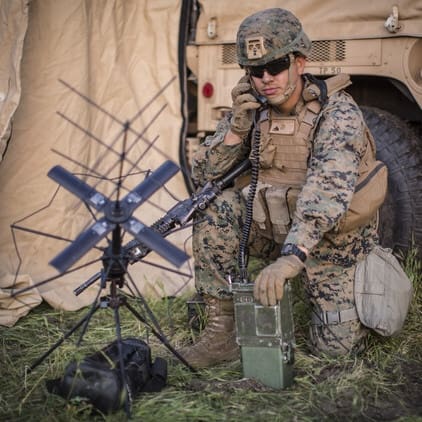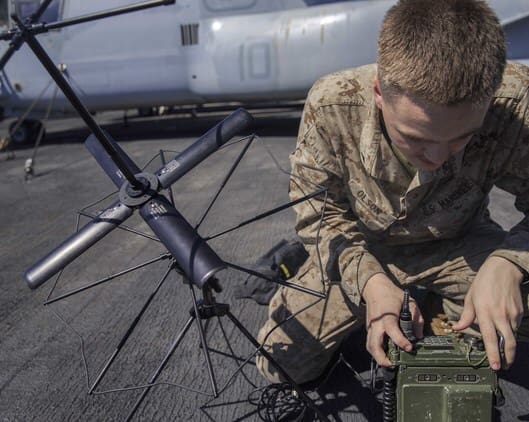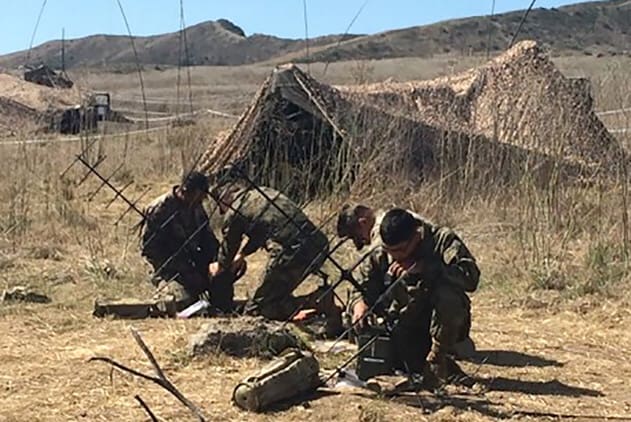MARINE CORPS BASE QUANTICO, Va. —
The Corps recently began fielding a next-generation narrowband satellite communication system that assists warfighters in connecting to networks on the battlefield.

Fielded in the first quarter of 2019, the Mobile User Objective System provides satellite communication capabilities to mobile or stationary Marines. The system enables the warfighter to leverage cellular technology to increase access to voice and data communication while using the MUOS network.
“MUOS is another way for warfighters to communicate in a tactical environment,” said Eddie Young, project officer of Multiband Radio II Family of Systems at Marine Corps Systems Command. “The system brings SATCOM capabilities in various formats to Marines.”
The MUOS capability encompasses updated firmware to the AN/PRC-117G radio system and one of three antenna kits. The antennas help Marines simultaneously access SATCOM networks and gives them secure and nonsecure internet access. MUOS also improves overall reliability in urban environments, challenging vegetation and other arduous conditions.

“MUOS is essentially software and an antenna capability augmenting existing hardware,” said Noah Slemp, systems engineer at MCSC. “It’s similar to adding an application to a cellphone.”
The first service to widely employ MUOS, the Corps is deploying thousands of antenna kits for the AN/PRC-117G radio system and hundreds of diplexers that enable vehicular systems to access MUOS satellites.
“The Marine Corps is leading all services in terms of getting MUOS to warfighters,” said Young.
Satellite communication has become increasingly important for the Corps in the 21st century. According to the Department of Defense, more than 50 percent of DOD satellite communication involves narrowband communication. Yet, this form of communication accounts for less than 2 percent of the DOD’s bandwidth, making it an efficient way to transmit information.
MUOS is particularly important because the SATCOM infrastructure of the legacy system is nearing its expiration, said Slemp. As a result, the Corps intends to incrementally replace the older capabilities with the MUOS waveform, enabling more Marines to access ultra-high frequency tactical satellite communications.
Prior to fielding MUOS, MCSC had to demonstrate to the Milestone Decision Authority that the system was safe, met technical performance and was ready to use by the warfighter. Since MUOS’s Field User Evaluation in 2017, Marines have raved about the benefits of the system.
“Our Marines find MUOS useful in completing their missions,” said Young. “We’ve received a lot of positive feedback thus far.”
The efforts of Young’s team in getting the system out to the warfighter have not gone unnoticed. In May 2018, at a Narrowband Working Group conference in Colorado Springs, Colorado, the Joint Staff J6 and the DOD Chief Information Officer recognized Young and Slemp for leading the services in employing MUOS.

The J6 and DOD CIO also emphasized the joint effort between the Multiband Radio II team and the Naval Information Warfare Center in using the Multiple Reconfigurable Training Systems, an interactive training aid that will be used to assist in the rapid fielding of MUOS.
“It was motivating to see that we were recognized for our efforts, because the team had put in a considerable amount of time and effort to make this happen,” said Young. “We recognize the warfighter needs this capability, and we’ve done everything we can to get it to them in a timely manner.”
Story by Matt Gonzales, MCSC Office of Public Affairs and Communication | Marine Corps Systems Command
Photos by LCpl Jason Monty, LCpl Tawanya Norwood & Eddie Young.

